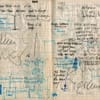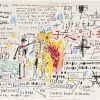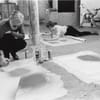What is the artist statement all about? When do you need it? And most importantly, how do you write one? In this article, we’ll answer these and other essential questions.
What is an artist statement?
An artist statement is a written description of your creative work. It provides context and background information and helps to clarify your intentions and artistic goals. An artist statement touches on your creative process, inspirations, and themes. It’s concise, clear, and reflective.
When to write an artist statement?
The statement introduces your work to potential buyers, galleries, curators, and other art world members. It’s an essential tool for:
Gallery exhibitions: When applying for gallery exhibitions or shows, curators and gallery owners will often ask for an artist statement to better understand your work and to see if it aligns with their mission and aesthetic.
Art fairs: When participating in art fairs or festivals, you will often be asked to provide an artist statement to be included in promotional materials and for your booth space.
Artist portfolios: An artist statement can be a valuable addition to your portfolio, providing context and background information that helps clarify your work’s meaning.
Artist websites: If you have a website, including an artist statement can help provide visitors with an in-depth understanding of your work and your creative vision.
Grants and awards: When applying for grants, residencies, or awards, you may be asked to provide an artist statement as part of your application materials.
Whether you apply for exhibitions, participate in art fairs, or showcase your work online, having a well-crafted artist statement is essential for promoting and advancing your creative career.
Is an artist statement written in the first person?
Yes, the artist statement typically uses the first person, as it allows you to directly express your thoughts, ideas, and intentions behind your art and to communicate your personal connection to your work.
How long should an artist statement be?
There are no fixed rules that define the length of an artist statement. We recommend writing 1-2 paragraphs, or roughly 150-350 words in total, which allows you to express your ideas without overwhelming the reader.
Don’ts
Overuse technical terms or jargon: Avoid using International Art English even if you’re writing for a specific audience familiar with this style.
Be too personal: While reflecting on your experiences and perspectives is important, your statement should focus on your work and its themes rather than your personal life. Writing about yourself applies more to the artist bio, in which you introduce your creative career.
Neglect to revise: Writing is rewriting. Read your statement several times and make revisions to ensure it represents your work and effectively communicates your ideas.
Artist Statement: Examples for Painters
- “I am a painter inspired by the natural world’s beauty and mystery. My paintings celebrate color, form, and texture and meditate on the relationship between light, shadow, and atmosphere. I work primarily in oil on canvas, using a combination of thick impasto and delicate glazes to create depth and luminosity in my work. My paintings are often landscapes, but they are not simply depictions of the world around us but rather an expression of my emotional and spiritual connection to the natural world. Through my work, I hope to evoke a sense of wonder and awe and to invite the viewer to consider the beauty and complexity of the world around us.”
- “I am a painter who explores the theme of human identity and the search for self-discovery. My work combines abstraction and representation, exploring the relationship between form, color, and emotion. I work primarily with oil on canvas, using a process of layering and wiping to build up the surface of my paintings. My goal is to create a sense of depth and complexity and to invite the viewer to look beneath the surface of my work to discover the emotional and psychological layers that are hidden there. My own experiences inspire my paintings. They are a reflection of the struggles, triumphs, and ambiguities that are part of the human experience, and they are an invitation to the viewer to reflect on their own lives and experiences.”
- “As a mixed media artist, I explore the relationship between nature and the man-made world. My work comments on human activity’s impact on the environment and celebrates the beauty and resilience of the natural world. I use various materials, including found objects, recycled products, and natural elements like branches and leaves. I enjoy the challenge of taking something discarded and giving it new life in my art. My creative process is heavily influenced by my background in sculpture and my love of nature. I often work with organic forms and incorporate elements of nature, like tree branches and leaves, into my pieces. I see my work as a way to bring a piece of the natural world into the man-made world and to encourage others to think about the environment and their impact on it. My goal as an artist is to raise awareness and start a conversation about the environment and the impact of human activity on it. Through my work, I hope to inspire others to think more deeply about their relationship with nature and their role in preserving the environment.”
Example of Digital Art
- “I am a digital artist drawing inspiration from the infinite possibilities of technology and the intersection of art and science. My work explores the relationship between digital media and the natural world, celebrating beauty and complexity. I create my work using a combination of digital tools, including 3D modeling software, animation tools, and programming languages, to build abstract and surreal landscapes filled with intricate patterns, vibrant colors, and flowing forms. I believe that digital art has the power to transcend time and space and to create new worlds and experiences for the viewer. As an artist, I aim to use this medium to inspire others, provoke thought and emotion, and help bridge the gap between technology and the natural world.”
Examples of artist statements for photography
- “As a fine art photographer, I draw inspiration from the beauty and mystery of the natural world. I use long exposures and intentional camera movement to create ethereal landscapes that blur the line between reality and fantasy. My goal is to evoke a sense of wonder and to encourage others to see the world around them in new and different ways.”
- “I am a street photographer drawn to the energy and chaos of urban environments. I aim to capture the human condition in all its variety and complexity, and I believe that there is beauty in the everyday moments that often go unnoticed. Through my work, I hope to reveal the poetry and unpredictability of city life.”
- “As a portrait photographer, I believe every human face tells a story. I use my camera to capture my subjects’ unique personalities and emotions. My goal is to create intimate and universal images that reveal the humanity and beauty in every individual.”
Statements by Renowned Artists
- “I want to express my feelings rather than illustrate them. As long as something is said, it doesn’t matter how the paint is put on. On the floor, I am more at ease. I feel nearer, more part of the painting since this way, I can walk around it, work from the four sides, and literally be in the painting. When I’m painting, I’m unaware of what I’m doing. Only after a get-acquainted period do I see what I’ve been about. I’ve no fears about making changes for the painting has a life of its own.” – Jason Pollock
- “I have never painted a self-portrait. I am less interested in myself as a subject for a painting than I am in other people, above all women… There is nothing special about me. I am a painter who paints day after day, from morning to night… Whoever wants to know something about me… ought to look carefully at my pictures.” – Gustav Klimt
- “I want the people in my pictures to stare back. I want to show exactly what my world looks like without glamorization, without glorification. This is not a bleak world but one in which there is an awareness of pain, a quality of introspection.” – Naan Goldin
- “By translating my hallucinations and my fear of hallucinations into paintings, I have been trying to cure my disease. I painted infinity nets daily; while doing so, the whole room appeared to have been covered with nets. So, I created pieces by covering sculptures with nets. I gradually feel myself under the spell of the accumulation and repetition in my ‘nets’ which expand beyond myself, and all over the limited space of canvas covering the floor, desk and everywhere.” – Yayoi Kusama
Crafting a well-written artist statement is an important step in establishing your personal brand and showcasing your work. By understanding your artistic vision, defining your unique voice, and presenting your work clearly and concisely, you can effectively communicate the story behind your art to a wider audience. Remember, your artist statement should be an evolving document that changes and grows as your art and your creative vision evolve over time. So, take the time to reflect on your work and focus on your message.
This text was created in collaboration with Open AI’s Chat GPT-4.




